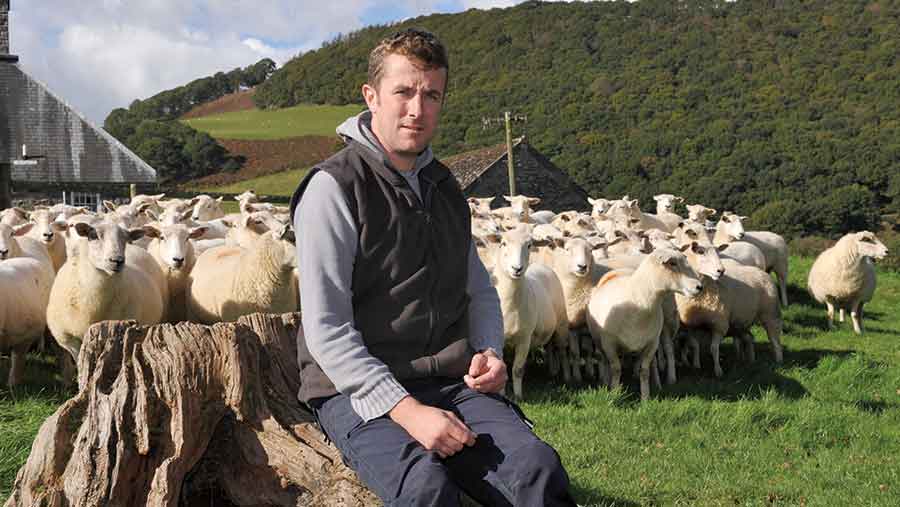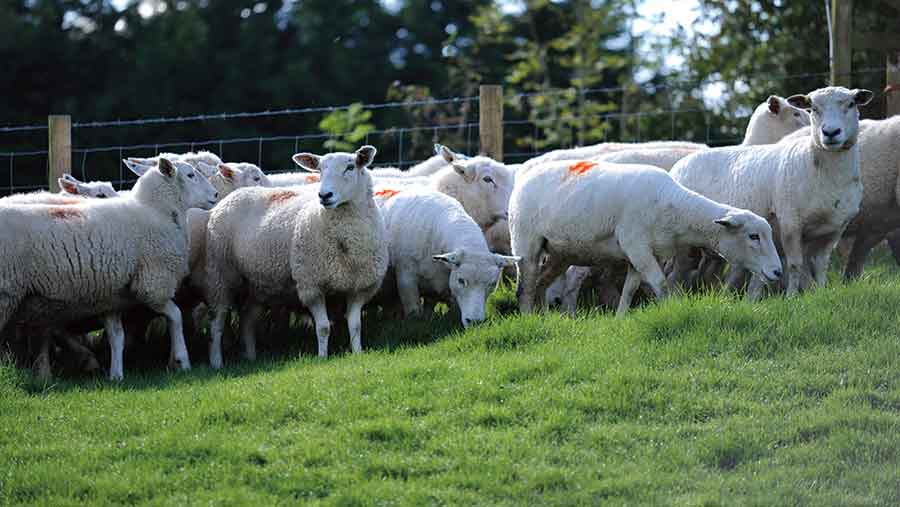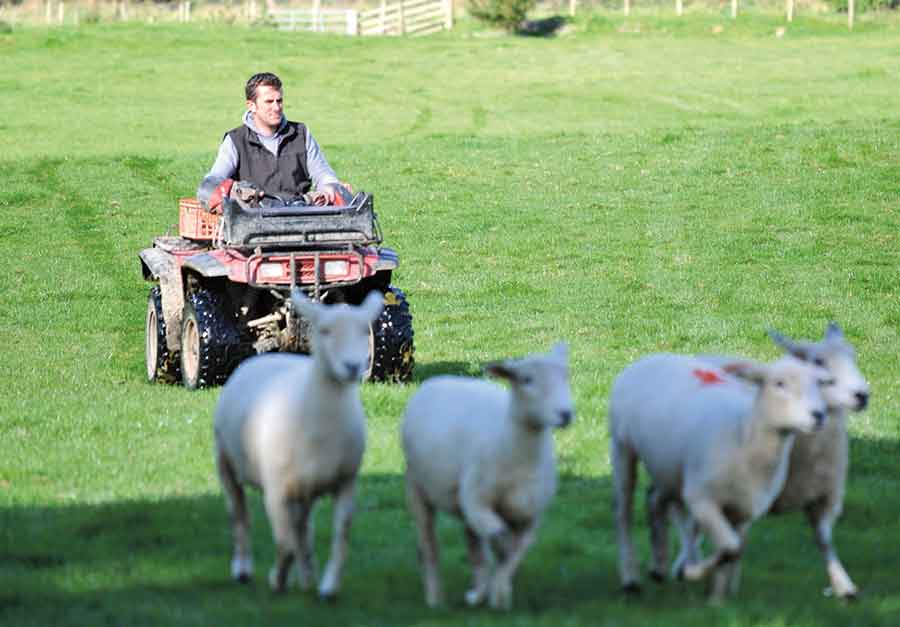How recording and rotational grazing can lift lamb weight gains
Lambs run on a simple rotational grazing system at a Powys farm are on average gaining an additional 40g in daily liveweight compared with weights achieved in the previous set-stocking system.
Sion and Gwawr Ifans’ early lambs are sold from 10 weeks, so maximising weight gains in that short time frame is key to flock profitability.

The couple has placed heavy emphasis on using maternal genetics to create a flock capable of lambing outside unassisted. Now they have achieved that, the focus has shifted to improving growth performance.
Their three-pronged approach includes using terminal sires, performance recording for lamb growth and switching from set-stocking to rotational grazing.
See also: Wet weather forces grazing changes on sheep farm
Although the grazing system is simple – only fields bigger than 2ha are split with electric fencing – there have been notable improvements in lamb performance.
“In the period up to eight to 10 weeks we are recording average gains of 285g compared with 250g in 2014. After weaning we are recording 225g, compared with 180g before,” says Mr Ifans.
The farm is growing more grass too, so much so that ewe numbers will be increased by 40% to 450 ewes within two years.
Mr and Mrs Ifans have been tenants on the 46ha Tanyffordd at Cemaes since 2008. They tup 320 New Zealand Romney, New Zealand Romney cross Aberfield and Texel-cross ewes and 40 ewe lambs.
Recording
They have recorded performance since 2009, initially tagging lambs at birth and matching every lamb to its dam. But that approach has been scaled back, with only lambs born from problem ewes linked to the dam.
“We were churning out a huge volume of information, but weren’t using it because an operation of this scale, we can’t cull for everything,” Mr Ifans explains.
“Recording everything is all very well, but unless you are getting something out of it, you have to question why you are doing it. I think you have to decide on two or three aspects of your flock that you think you can improve on by recording and concentrate on those.”
At Tanyffordd, the focus is on increasing the growth rates of the lambs within the first eight to 10 weeks by adopting an “elite” ewe lamb selection policy based on lambing data, growth rates and lameness.
This year every lamb was tagged at birth, but lambing reports were only generated for problem ewes and their lambs.
“When it comes to weaning or selecting cull ewes, I use this information to group them accordingly,” says Mr Ifans. Ewe lambs from problem ewes are culled.
The principle reasons for culling ewes are lambing assistance and lameness. A yearling assisted at lambing will get a second chance, while for lameness every animal gets two strikes and after that they are out.

“We have noticed big improvements in lameness – recording is really paying dividends,” says Mr Ifans.
Lamb birth weights are recorded and their daily liveweight gains monitored. “Monitoring growth is in my view the most important tool in the recording process, especially after weaning. I use it to draw out lambs that are growing at less than 200g/day and act accordingly.”
This could involve fecal egg counts (FEC). Mr Ifans has invested in a FEC system that allows microscopic-scale images of mixed samples to be sent to a laboratory, with a reading generated within 15 minutes.
The Ifans family aims to sell lambs as early as possible, with the first sold off their mothers in June, at 10-11 weeks, at an average of 15.5kg deadweight. Lambs are sold to Randall Parker Foods to supply the export market.
Change in sire
But Mr and Mrs Ifans are now changing their system to achieve higher weights – 17kg-18kg. To achieve this they are crossing the Romneys with an Aberfield or Texel tup instead of a Romney.
“Romneys are excellent maternal ewes, but at eight to 10 weeks, lambs suddenly grow lots of wool instead of flesh,” observes Mr Ifans. “We are hoping the Texel blood – based on Signet recording with rams purchased in the top 1% at eight- and 21-week weights – will this year produce some quick-growing lambs.”
It will also avoid the need to shear the pure Romney ewes for a second time in mid-September. “Their fleeces become very heavy in the winter if we don’t shear a second time and this affects their body condition score,” says Mr Ifans.
Management
The flock is tupped at the end of October and in mid-January animalsare housed on silage, with a concentrate incorporating a high soya content introduced six weeks before lambing.
This policy allows for grass cover at lambing and helps to minimise poaching, says Mr Ifans.
“We have a lot of leys that are younger than five years and if it’s wet, which it usually is, heavily pregnant ewes would poach the ground quite badly.’’
The ewes are then turned out again seven days before lambing, in groups according to the number of lambs they are carrying. Lambing gets under way at the end of March.
To achieve finishing weights at 10-11 weeks, creep feed is introduced to the terminal-sire lambs at three weeks.
“That really gets them going,” says Mr Ifans. “We run the terminal- and maternal-sire lambs in different sections of the farm so they are all of the same type and we can creep the right ones.”
Groups are amalgamated after six weeks, with about 400 ewes and lambs grazing a 2ha field for up to four days. Mr Ifans makes a visual assessment of the covers and residuals.
“If the residual is where I want it to be in the desired time period, I am confident that field is performing. If all the elements are correct but the field is not performing, we will grow a field of stubble turnips there because that suits our Glastir contract. We will reseed it the following year.”
Lambs are weaned no later than 13 weeks, with 12 weeks the optimum time.

Any lambs that haven’t been sold before September are marketed as stores. “Our approach is to not be scared of selling lambs as stores. Stores can be very economic and this is one of the reasons why we are crossing the pure Romneys, as they don’t sell very well as stores. Crossing will provide an opportunity to sell bigger framed store lambs in August.”
Once lambs are sold, the focus shifts to ewe body condition score, with ewes at a minimum of condition score 3 before tupping.
Any animals that are 2.5 or higher are allocated rough grazing – there are 10ha of rough grazing on the farm – together with the replacement ewe lambs. Ewes that are below condition get the better grazing.
“We had been guilty in the past of just focusing on the lambs and coming to September and realising that we had been too late in getting the ewes in the right condition,” Mr Ifans admits.
Attention to body condition score has paid dividends – the flock scanned at 181% last January compared with 165% the previous year.
